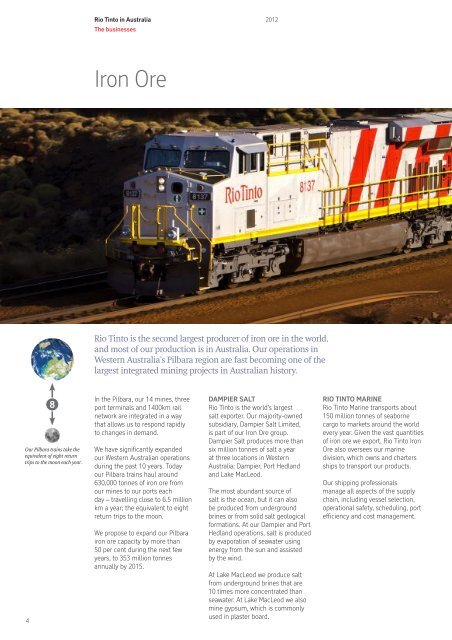Rio Tinto in Australia - PageSuite
Rio Tinto in Australia - PageSuite
Rio Tinto in Australia - PageSuite
- No tags were found...
Create successful ePaper yourself
Turn your PDF publications into a flip-book with our unique Google optimized e-Paper software.
<strong>Rio</strong> <strong>T<strong>in</strong>to</strong> <strong>in</strong> <strong>Australia</strong>The bus<strong>in</strong>esses2012Iron Ore<strong>Rio</strong> <strong>T<strong>in</strong>to</strong> is the second largest producer of iron ore <strong>in</strong> the world,and most of our production is <strong>in</strong> <strong>Australia</strong>. Our operations <strong>in</strong>Western <strong>Australia</strong>’s Pilbara region are fast becom<strong>in</strong>g one of thelargest <strong>in</strong>tegrated m<strong>in</strong><strong>in</strong>g projects <strong>in</strong> <strong>Australia</strong>n history.Our Pilbara tra<strong>in</strong>s take theequivalent of eight returntrips to the moon each year.48In the Pilbara, our 14 m<strong>in</strong>es, threeport term<strong>in</strong>als and 1400km railnetwork are <strong>in</strong>tegrated <strong>in</strong> a waythat allows us to respond rapidlyto changes <strong>in</strong> demand.We have significantly expandedour Western <strong>Australia</strong>n operationsdur<strong>in</strong>g the past 10 years. Todayour Pilbara tra<strong>in</strong>s haul around630,000 tonnes of iron ore fromour m<strong>in</strong>es to our ports eachday – travell<strong>in</strong>g close to 6.5 millionkm a year; the equivalent to eightreturn trips to the moon.We propose to expand our Pilbarairon ore capacity by more than50 per cent dur<strong>in</strong>g the next fewyears, to 353 million tonnesannually by 2015.Dampier Salt<strong>Rio</strong> <strong>T<strong>in</strong>to</strong> is the world’s largestsalt exporter. Our majority-ownedsubsidiary, Dampier Salt Limited,is part of our Iron Ore group.Dampier Salt produces more thansix million tonnes of salt a yearat three locations <strong>in</strong> Western<strong>Australia</strong>: Dampier, Port Hedlandand Lake MacLeod.The most abundant source ofsalt is the ocean, but it can alsobe produced from undergroundbr<strong>in</strong>es or from solid salt geologicalformations. At our Dampier and PortHedland operations, salt is producedby evaporation of seawater us<strong>in</strong>genergy from the sun and assistedby the w<strong>in</strong>d.At Lake MacLeod we produce saltfrom underground br<strong>in</strong>es that are10 times more concentrated thanseawater. At Lake MacLeod we alsom<strong>in</strong>e gypsum, which is commonlyused <strong>in</strong> plaster board.<strong>Rio</strong> <strong>T<strong>in</strong>to</strong> Mar<strong>in</strong>e<strong>Rio</strong> <strong>T<strong>in</strong>to</strong> Mar<strong>in</strong>e transports about150 million tonnes of seabornecargo to markets around the worldevery year. Given the vast quantitiesof iron ore we export, <strong>Rio</strong> <strong>T<strong>in</strong>to</strong> IronOre also oversees our mar<strong>in</strong>edivision, which owns and chartersships to transport our products.Our shipp<strong>in</strong>g professionalsmanage all aspects of the supplycha<strong>in</strong>, <strong>in</strong>clud<strong>in</strong>g vessel selection,operational safety, schedul<strong>in</strong>g, portefficiency and cost management.
















